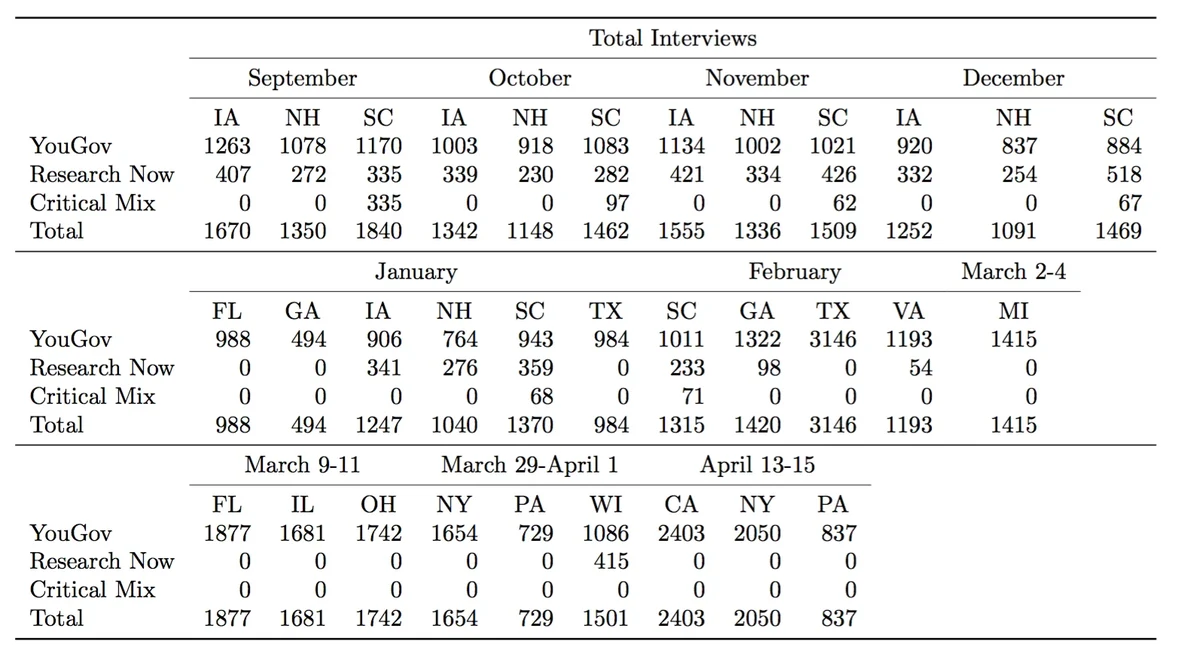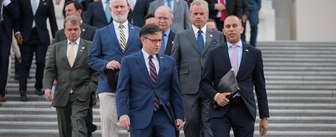How the poll was conducted and the margin of error calculated
The CBS News 2016 Battleground Tracker is a panel study based on interviews conducted on the internet of registered voters in California, Florida, Georgia, Illinois, Iowa, Michigan, New Hampshire, New York, Ohio, Pennsylvania, South Carolina, Texas, Virginia, and Wisconsin. The poll was conducted by YouGov, an online polling organization.
The first wave was fielded between September 3-10, 2015, with 4860 respondents, and the second wave fieldwork was completed between October 15-22, 2015, with 3,952 respondents and the third wave between November 15-19, 2015. The fourth wave was fielded between December 13-17, 2015. The majority of the 2nd-4th wave respondents are recontacted panelists. The first 4 waves consist of interviews in Iowa, New Hampshire, and South Carolina only. The fifth wave added new interviews in Florida, Georgia, and Texas, and was completed between January 17-21, 2016. The sixth wave was fielded only in South Carolina, with interviews completed February 10-12, 2016. The seventh wave was fielded also in February, among panelists in Georgia, Texas, and Virginia. The eighth wave fielded February 22-26, 2016, and recontacted panelists from the January wave in Georgia and Texas. Virginia respondents were all new to the panel. The nineth wave was fielded to new respondents in Michigan from March 2-4, 2016, and in addition, respondents in Florida, Illinois, and Ohio were contacted March 9-11, 2016. Respondents in New York, Pennsylvania, and Wisconsin were contacted March 29-April 1, 2016 for the tenth wave. In the eleventh wave of our primary surveys, respondents in California, New York, and Pennsylvania were contacted April 13-15, 2016.
Respondents were selected from YouGovs and two other online panels. These are “opt-in” panels which are open for anyone to join. However, YouGov also randomly selected persons from voter registration lists who had previously voted in primary elections and contacted them by phone. A total of 24,017 registered voters were contacted by phone and the YouGov sample includes 1,821 phone recruits.

For the October, November, and December waves, all respondents from previous waves were contacted to participate. In the January wave, all respondents from previous waves in Iowa, New Hampshire, and South Carolina were contacted to participate. Florida, Georgia, and Texas are completely new interviews. In the February wave, all respondents from previous South Carolina waves were contacted to participate. In the March wave, all respondents from the previous Florida wave were invited to participate. All respondents from the New York survey in late March were invited to participate in the April wave.
Recontact rates ranged from 34% to 75% for each state. In addition, new respondents were selected from the YouGov panel each wave. Approximately 60% of the October wave consists of reinterviews, with the remainder coming from new additions. Approximately 70% of the November wave consists of reinterviews from the previous waves, approximately 90% of the December and January waves consist of reinterviews. Approximately 84% of the February South Carolina wave consists of reinterviews. In the February SEC Primary wave, Republican respondents from the January wave in Georgia and Texas were invited to participate. We did not interview Democrats in these states in January. Similarly, Republican respondents from the January wave in Florida were invited to participate in the mid-March wave, and Republican respondents from the late-march wave in Pennsylvania were invited to take the April wave. Approximately 60% of the New York and Pennsylvania portions of the April wave consist of reinterviews; all California respondents were new interviews this month.
All respondents in Florida (January), Virginia (February), Michigan (early March), Illinois and Ohio (mid-March), Wisconsin (late March), and California (April) only participated in one wave. Reinterviews are summarized below.*
Respondents were selected for participation from available panel members to be representative of registered voters from each state in terms of age, race, and gender. A propensity score (based upon a case-control logistic regression including age, race, gender, education, born-again status, and party registration) was estimated for each respondent and responding panelists were post-stratifed upon propensity score deciles, and adjusted for differential recontact from the prior wave. A score for likelihood of voting was computed for each respondent based upon past turnout and self-reported likelihood of voting in the presidential primary.
Finally, the product of the base weights and turnout probabilities were raked to match parameters from past primary and general elections in the state drawn from exit polls, and aggregate parameters from the current voter file. The weights were trimmed to have a maximum value of seven.
The “margin of error” is an approximate 95 percent confidence interval for the sampling proportion. It is calculated for a sample proportion using

where CV is the coefficient of variation of the sample weights and n is the sample size used to compute the proportion. This is a measure of sampling error (the average of all estimates obtained using the same sample selection and weighting procedures repeatedly should, in principle, be within the margin of error in 95 percent of such samples). It does not reflect non-sampling errors, including potential selection bias in panel participation or in response to a particular survey. The validity of the margin of error for total survey error (including non-sampling error) requires that, after controlling for the sample selection and weighting variables, survey measurements be independent of sample selection.
*Florida, Georgia, Pennsylvania and Texas counts are Likely Republican Voters only. Democratic voters were not contacted in the first wave.
Updated: 1030AM EST 4/17/2015








